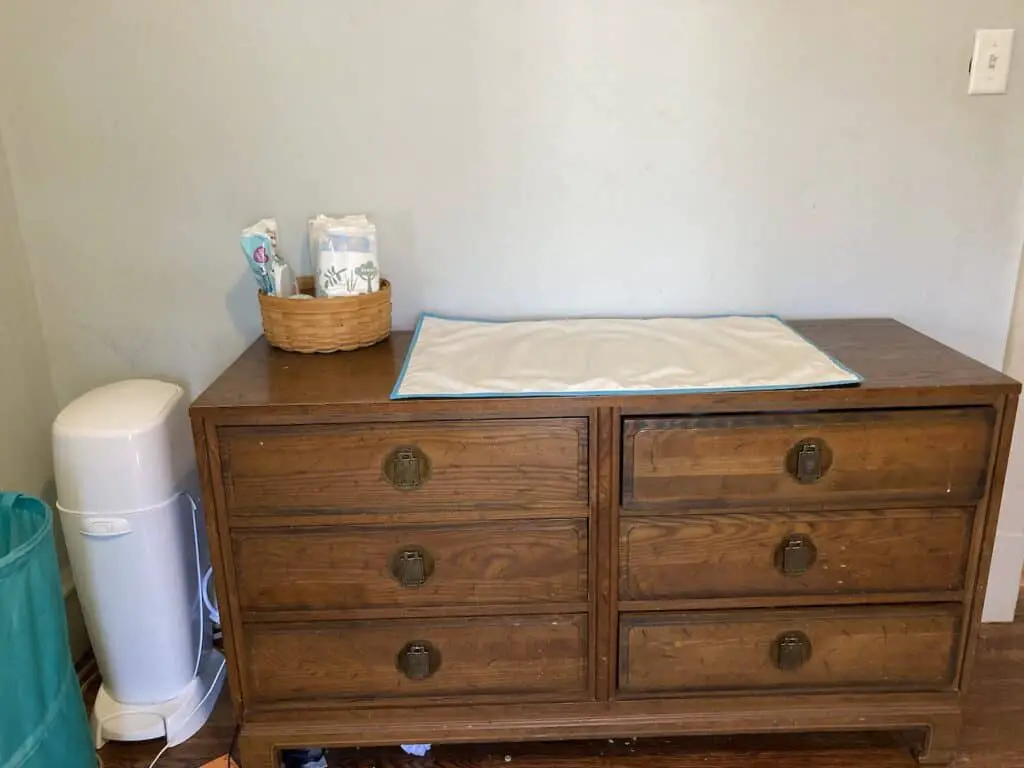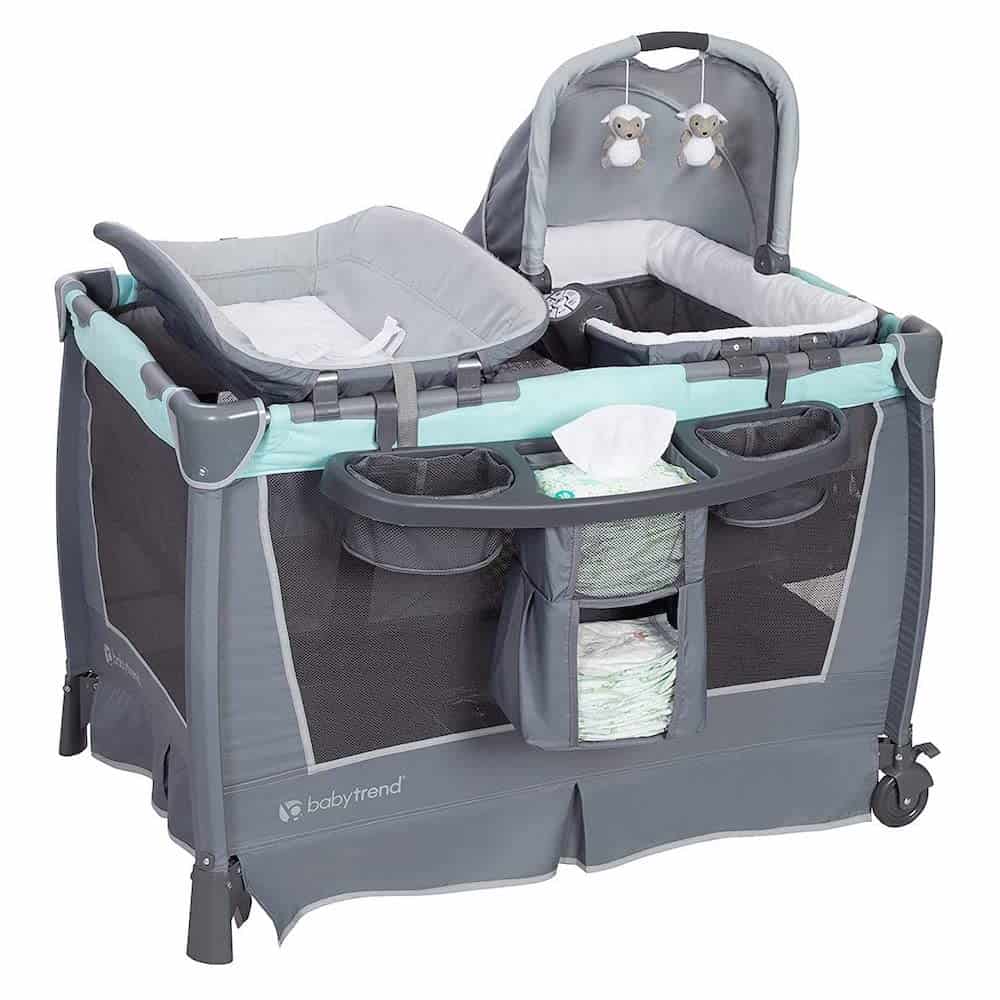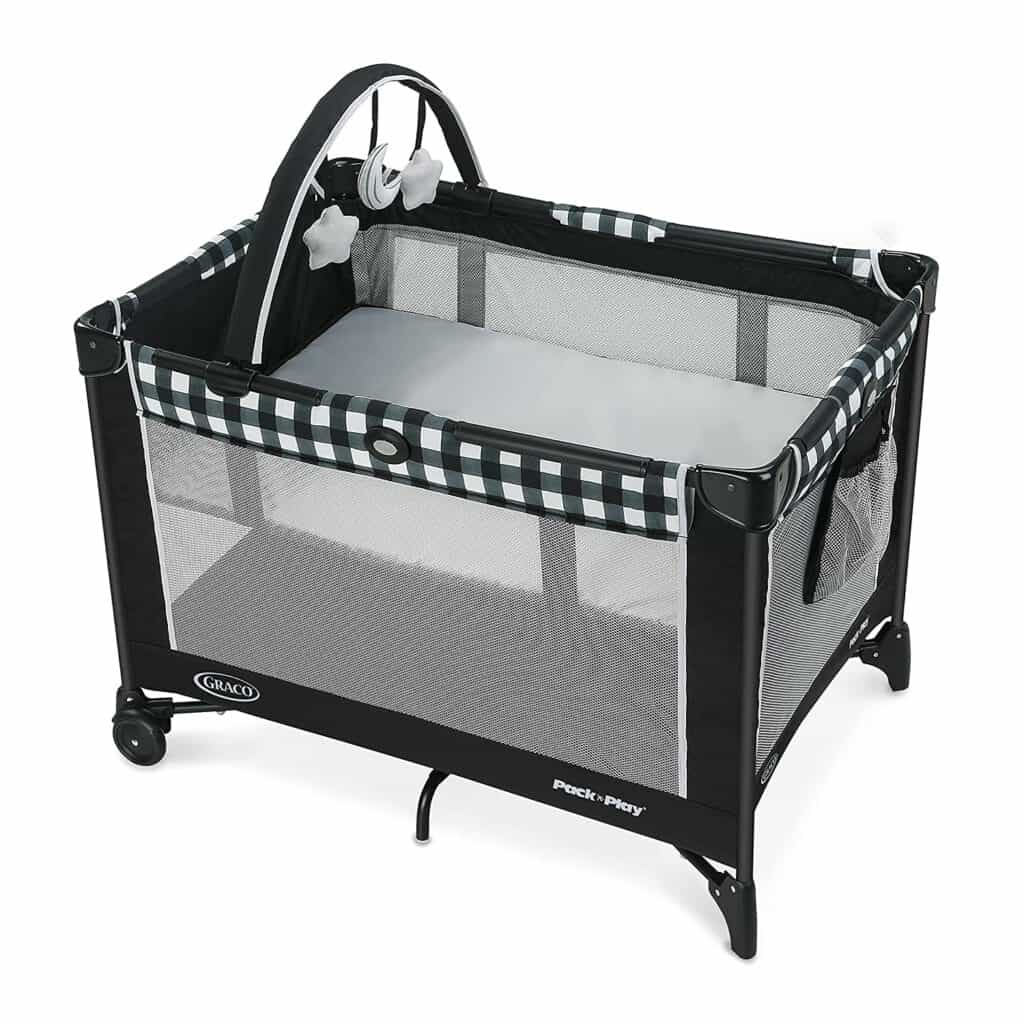I tend to talk a LOT about diapering topics here on this website. I’ve covered the whether or not you need a diaper bag, the cheapest wipes, and even a big breakdown comparing the cost per diaper of eleven major diaper brands.
But can you blame me? Diapers are expensive and a hassle, not to mention changing your baby (or alligator-wrangling your toddler) is less than pleasant.
So today, to continue my “Do you really need a…” series, I’m tackling the infamous changing table. My mom had one in the 90s that promptly turned into baby book storage, so I never bothered to get one. Nowadays, I have plenty of mom friends who have them, but just as many without. So what does the average parent think about changing tables? I had a hunch, but I wanted to be sure.
This week, I did the research. I went into one of my favorite (zero drama) mom groups on Facebook and asked the pros what they thought. This survey is now my record-holder for most responses ever at 821, plus more than 200 moms left comments describing their set ups, preferences, and even sharing links to the products they use. Here’s what they had to say.
(And if you’d like to read about ALL the baby products 6,000 moms did (and didn’t) recommend over my six months of research, you can read my essentials-only baby registry checklist article here!)
So…do I really need a changing table?
77% of surveyed moms said you definitely don’t need a changing table. Most commonly, they described the how much easier a ‘mobile’ diaper changing station is, plus the expense of a bulky piece of furniture that’s only useful for a few months.

Countless moms repeated stories like Rhihann’s, who said, “I have one and my mom was like “it’s a waste of money, I promise.” She was 100% right.”
Why? Because even the most low-budget changing tables start at around $75 and take up valuable real estate in a baby’s nursery. Changing tables also can’t convert to become any other kind of furniture, so you can’t even use it for something else later on.
Baby gear companies have tried to get more people to buy crib/changing table combinations, but they still are only really useful for a few months. At around 4 months old, babies learn to roll over, and that’s when it starts being easier to change kids on the floor or closer to the ground, in case they wiggle too much. Even if you had a crib/changing table combo, this short time of usefulness is still a problem most parents didn’t think was worth dealing with.
Does anyone need a changing table?
Though they were in the minority, a few moms made a good case for getting a changing table. Of those who said they needed one, the most common reasons were lack of personal mobility, multiple children, fears of messes, and small houses.
The older you are (looking at you, poorly named “geriatric” pregnant ladies), the less likely you’ll be interested in squatting down on the floor or hunching over the couch a half dozen times a day. One self proclaimed “old mom” named Desirae said using a changing table “saves my back.” And of course, there are plenty of people who had chronic back pain even before their baby came around!
Even if you’re usually flexible, the immediate postpartum period often means dealing with some limited mobility. This can include scar or incision pain if you had stitches or a c-section, too. Having an elevated surface can really make diaper changes easier in these scenarios.
Another mom, Tatianna, pointed out that “if you’re going to have multiple kids, then a changing table could be useful and you’ll get your money’s worth.” This is because moms of many kids have multiple instances of a <4 month old in the house.
Some parents just don’t want to deal with the threat of blowouts or (especially if you have a son) geysers all over their bed, couch, or other fabric surface. Especially if you have nice furniture or even heirlooms! A changing table is easy to wipe down, so even messes aren’t too hard to clean up.
Finally, a few parents with small, ranch-style homes or apartments mentioned the space-saving convenience of a single diaper changing station. Isabelle mentioned in a comment that, “We have an itty bitty apartment and use our [changing table] for 97% of diaper changes. However, if we had a big house and had to go all the way across the house to do it, we probably wouldn’t.”
Of course, it’s worth pointing out that many of these problems have solutions other than a changing table, but we’ll get to that in a second.
What about a diaper caddy? How do you organize supplies without a changing table?
One of the most common benefits baby gear companies pitch for buying a changing table is easy, all-in-one-place storage. So what do parents who go without DO with all the wipes, diapers, diaper cream, and other supplies necessary for changes?

The answers I received were almost as varied as the parents themselves. While you don’t need to run to the store for a specially designed ‘diaper caddy’ (which is just a normal organizer with the ‘baby tax’ added), you will want something to keep your supplies on-hand. You don’t want to realize you’re missing something when your baby is mid-change!
To solve these problems, parents get creative. Here are a few of their ingenious solutions for organizing all the diaper changing gear:
- Cloth bins
- Baskets
- A designated dresser drawer
- Tote bags
- Pack ‘n play with the ‘diapering supplies organizer’ attachment (shown further down in the article)
- Over-the-door shoe organizers
- A shelf
- Your diaper bag
- A three-tiered rolling cart
- And of course, an actual diaper caddy
Honestly, a cardboard box would technically work. But in my opinion, it feels nice to have something pretty contain all the supplies for such a usually unpleasant chore. The basket picture above is my solution for our downstairs mobile changing station- a basket I got at the thrift store for $3. Not bad!
Alternatives to a changing table
A normal dresser

You can see my family’s dresser diaper changing station above (complete with the broken diaper genie I still haven’t thrown away…but I get into that story more in my article on whether or not you need a diaper pail.)
By far the most common furniture alternative to a changing table, with 55 comments independently suggesting it, was a normal dresser. This can be as fancy as a specially-purchased dresser from a nursery set, or as simple as an adult dresser you find at a thrift store. Bridgett uses a dresser and commented, “it’s nice to be able to stand straight up for changes instead of leaning over at weird angles and hurting my back.”
If you do choose this alternative, you’ll probably want some kind of changing pad underneath to separate your baby (and their potential bodily fluids) and the furniture. As you can see above, we use a flat mat in my house, but plenty of parents said they preferred the curved style.
Lauren linked this contoured, portable changing pad on Amazon, which she uses on top of her dresser. It’s also well-loved according to Amazon reviews as well.
Other flat furniture
Some moms also reported using side tables, storage units, sturdy bookshelves, or (as Alyssa said) “any flat surface I don’t put food on.”
Basically, what I learned from my research is that anything flat and waist-high can become a changing table. It might help to measure your or your partner from the hip to the ground, as that’s roughly the height you’ll want any makeshift changing table to sit at. If the two of you (or whoever else will regularly do diaper changes) are very different heights, try finding something that sits comfortably in the middle. You want to avoid anything below one person’s waist, as that will mean lots of awkward bending.
A regular side table was Catherine’s solution, which she described in a comment, “We have a literal table that we put a changing mat on. [We] put drawers under to hold diapers and such.”
On-the-go diaper changes
Especially once children are more mobile, most parents said they just change their child wherever the need arises. Common suggestions were to change on the floor, couch, bed, and even standing up (for the toddlers who would otherwise fight too hard).
Change them wherever, but have a foldable mat handy. This is especially good if you have a “roller” and you’re worried they’ll fling themselves off a higher platform like a changing table or dresser. Julia says “I just use those little flimsy changing mats on the couch, on the bed, wherever is convenient.”
Taylor also uses this system, commenting, “I change them on any surface but I do use a changing pad if they are very poopy so I can wipe it off if needed…I just throw it on the floor when I use it.”
This flat, foldable style of changing pad often comes with diaper bags, but you can find them for as little as $5 on Amazon (like this Ubbi brand one). But be sure to find one that’s JUST a changing pad, and doesn’t require careful unfolding or have specialty pockets for storing items. You’ll want to be able to shake it out to full size with one hand while holding a baby in the other!
A pack ‘n play
In my article on whether or not you need a pack ‘n play, I covered two kinds that pertain to this discussion. Some have a removable, elevated changing table attachment. Others have raised, full-sized bassinet portions that also can be used as a diaper changing location since they require less bending over than a couch or the floor. A dozen moms mentioned they used one kind or another as their primary changing table set-up.


You can see in the first image the style that also includes storage for diapers, wipes, and other diaper changing essentials. This can be great for moms dealing with a lack of storage space in their homes.
And that’s a wrap! Hopefully, the above is enough to make a decision about whether a changing table is a good decision for your family. Fun fact: I was only interrupted twice to do diaper changes while writing this!
If you want to get more updates and tips about how to get ready for and raise a baby on a budget, be sure to subscribe to my newsletter below.
